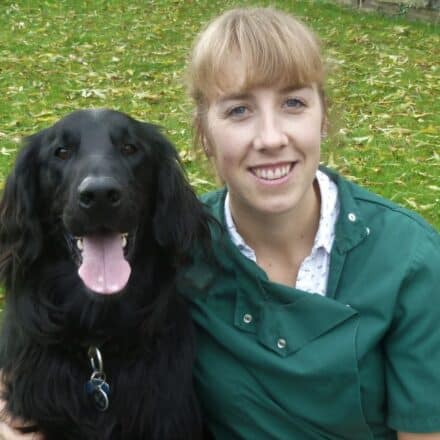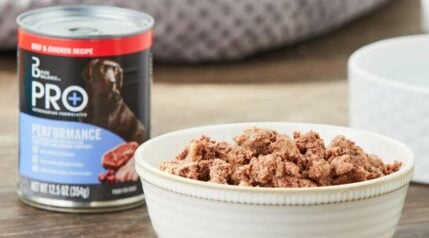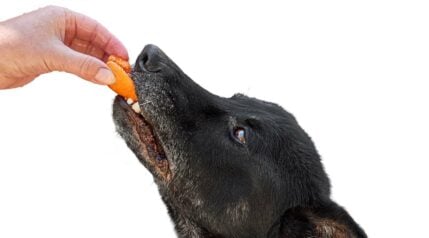We all know that the right food is important, but did you know that a dog’s nutritional needs change as they grow and age?
The amount of food and the type may need to change as your dog transitions between different stages of its life.
Let’s explore the factors to think about when initially choosing a diet, the proper amount to feed, and some considerations for each stage of your dog’s life.
How Is Dog Food Regulated?

The FDA ensures that the ingredients used in pet food are safe and are included for the right reason. The FDA also makes sure that manufacturers disclose certain information on pet food labels, including the product name, the manufacturer, and the proper list of ingredients ordered from most to least in terms of weight.
Some states also insist on that further information be included on packaging, following a model from The Association of American Feed Control Officials (AAFCO). AAFCO is a voluntary membership association made up of individuals who regulate animal feed sales and distribution. It also helps to define common ingredients and nutritional requirements for pet foods.
Looking for products with AAFCO approval gives you additional confidence that the pet food you purchase is suitable for your dog based on their life stage. It also confirms that any nutritional claims made by the manufacturer are accurate.
What Should I Look For When Choosing My Dog’s Diet?

Here are some general tips when choosing a diet for your dog:
Choose a Diet That Is Appropriate for Your Dog’s Size and Life Stage
Pick a diet for your dog’s size and life stage, considering whether it is a puppy, adult, or senior. The FDA regulates all foods, but you want to try and choose a diet that has additional AAFCO approval to guarantee any claims made by the manufacturer.
Decide on How Much You Want to Spend
Cost is a significant factor for many dog parents when choosing a diet. It can be hard to know what you are getting for your money and the differences between various price points.
The World Small Animal Veterinary Association (WSAVA) has created a list of recommendations for pet parents selecting a diet. So, once you have given some thought to your budget, you could explore different brands further by using those recommendations.
There is also a comparison page on the Pet Nutrition Alliance’s website where some of the WSAVA’s questions have already been asked of of manufacturers. This may prove a useful way to see what you are getting for your money because it explains whether a company employs qualified veterinary nutritionists and provides straightforward answers to nutrition questions.
Decide Whether to Feed Wet or Dry Food
Think about whether you want to feed your pet wet or dry food (or a combination). Dry foods are usually easier and less messy than wet foods, but some animals prefer the texture of wet food, particularly puppies.
Ingredients to Seek Out
Looking at the ingredients list tells you a lot about the diet. A good quality dog food has animal-based protein ingredients at the top of its lists, such as meat, meat meal, and meat by-products. A diet like this is a good source of protein and contains lower amounts of other carbohydrate-based ingredients. AAFCO has some helpful information on how to interpret the ingredients list further.
It’s worth mentioning that exotic-sounding ingredients don’t necessarily make a diet better. While emu, flaxseed, or kale sound good to us, they don’t add a lot nutritionally for our pets. Manufacturers can charge more for fancy-sounding foods, even if they only contain a tiny amount of these ingredients.
What Should I Feed At Different Life Stages?

As a rule, if you have selected a complete commercial diet that states it is suitable for your dog’s size and life stage (and has AAFCO approval for this), then you can’t go far off course. However, it is worth breaking down the various life stages and looking at the sorts of things that dogs need at specific ages in more detail.
Newborn Puppies
Newborn puppies get all their nutrition from their mother’s milk. There are some scenarios where puppies might need hand-rearing with commercial milk replacement fed via a small bottle with a nipple. These pups need regular feedings throughout the day and night, approximately once every 2-4 hours to start.
The milk replacer has specific instructions, but most puppies need about 180ml per kilogram of body weight per 24-hour period. If you are unsure how to feed your newborn, ask your veterinarian for help.
When puppies reach 3-4 weeks, they start to wean and begin trying solid food. Offer them food that has been mixed with warm water or some puppy milk replacer to make a wet gruel-type mixture and allow them to explore in their own time.
Young Puppies
By the time puppies are 8 weeks of age, they usually have weaned off milk and solely rely on solid food. Puppies of this age still have relatively small stomachs and need four small meals a day.
Consult the guidelines on your puppy’s commercial food label. This tells you how much you should give him per 24-hour period. Divide this total into 4 portions used for each meal (4 meals per day). Puppies of this age no longer require milk, so make sure yours has fresh water down at all times instead.
As your puppy grows to 4 months of age, he can start having three meals a day. When he reaches 6 months, reduce to twice-daily feeding. Again consult the packaging instructions but divide the total daily amount into 2 portions instead of 3 or 4.
Puppy foods are high in calories and protein, supporting growth and development. They are also designed to be readily digestible. Some young pups may like their dry kibble soaked in water to soften them a little if they struggle with hard food in the early days.
Adult Dogs
The exact onset of adulthood varies according to breed, but it tends to be around 12 months on average. Some large or giant dogs take longer to reach their full adult body size. So, consult your vet to determine when your dog is ready to graduate to adult food.
Once your dog is an adult, he needs to be on an adult diet that is appropriate for his size (i.e., a toy/small, medium, large, or giant diet). If you continue feeding puppy food to an adult dog, they could gain unwanted weight, as they no longer require the same amount of nutrients as a young, growing puppy does.
You should feed adult dogs twice a day to help keep them satisfied. Once-daily feeding can lead to hunger and frustration. Consult the packet feeding guidelines and make sure you weigh out the food accurately. Monitor your dog’s body condition score (see below) to ensure he stays at his optimum weight. Some very active dogs need a bit more food, whereas more sedentary animals may need a bit less.

Mature (7+ Years) And Elderly Dogs
Dogs of this age may start to show signs of slowing down, and you might want to look at a diet that helps support them. Changing energy levels might mean they need a diet with fewer calories – however, they still need good quality nutrition to help support organ function as they get older.
Again, there is some breed variation, with large or giant dogs aging faster than small breed dogs.
Some diets for older dogs contain additional ingredients such as joint supplements to help with the effects of osteoarthritis or antioxidants and omega-3 to help with declining cognitive function.
Mature and elderly dogs should still be fed twice daily, weighing the food out accurately as per the packet guidelines. Continue to monitor your dog’s body condition score and weight to make sure you are keeping things under control.
Frequently Asked Questions

What should I feed my pregnant dog?
Pregnant dogs only require slightly more energy than other adults in the early stages. But as they reach the final third of their pregnancy, their energy demands increase, so you should transition her over to a high-energy diet, like puppy food. She continues with this after the birth of her puppies while she is lactating.
How often should I feed my puppy?
Your puppy should have four small meals a day up to the age of 4 months, then reduce this to three meals a day until they are 6 months. Beyond this, they can have two meals a day, which you should continue for the rest of their life.
How do you know if you are feeding your dog the right amount?
Check that you are following the guidelines on the packet and weighing your dog’s food out accurately with measuring scales. Monitor your dog’s body condition score and ask your veterinarian for advice if you are worried your dog is under or overweight.
Final Thoughts
Before exploring how much to feed your dog, you should first decide what you will feed them. Choosing a good quality AAFCO-approved diet that is appropriate for your dog’s life stage and size is the first step.
Once you have selected the diet, follow the instructions on the packaging and split the recommended daily amount into the proper number of meals based on your dog’s age. If you are still unsure, speak to your veterinarian. Many pet food manufacturers also have helplines you can call for advice about their diet.





